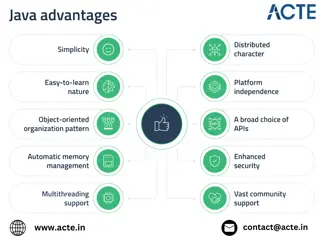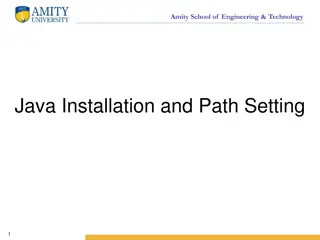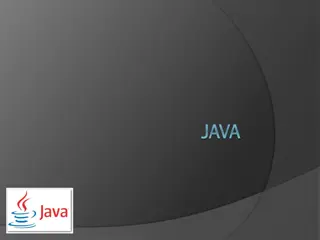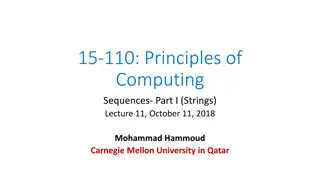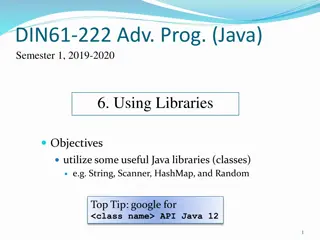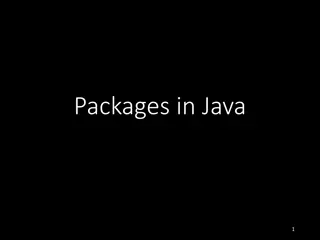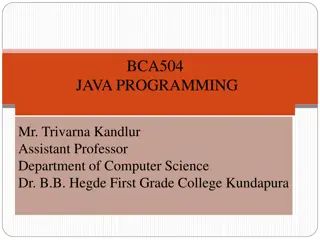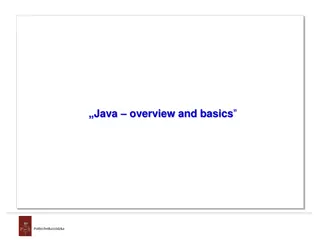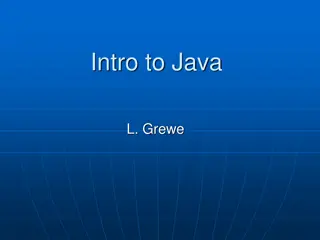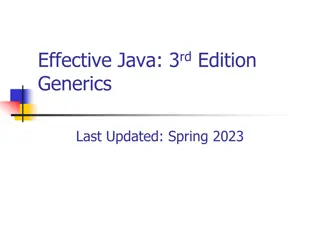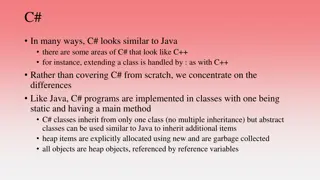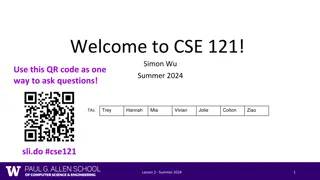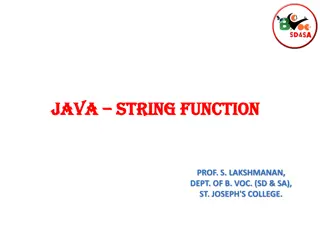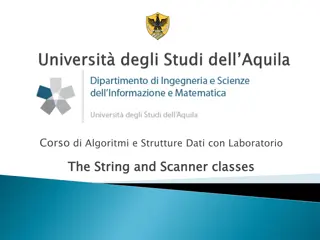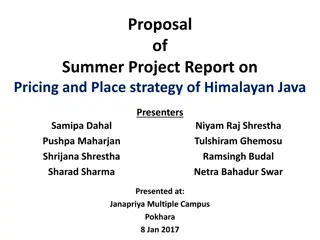String Comparison in Java
This discusses how String comparison works in Java, focusing on the equals() method, == operator, and potential pitfalls for new programmers. It clarifies the difference between comparing contents and references of String objects, providing examples for better comprehension.
Download Presentation

Please find below an Image/Link to download the presentation.
The content on the website is provided AS IS for your information and personal use only. It may not be sold, licensed, or shared on other websites without obtaining consent from the author.If you encounter any issues during the download, it is possible that the publisher has removed the file from their server.
You are allowed to download the files provided on this website for personal or commercial use, subject to the condition that they are used lawfully. All files are the property of their respective owners.
The content on the website is provided AS IS for your information and personal use only. It may not be sold, licensed, or shared on other websites without obtaining consent from the author.
E N D
Presentation Transcript
The general subject of comparing objects, or object references, can be introduced concretely with strings. Recall that String is a class, and so strings themselves are instances of this class. The String class implements a method called equals(). This is the method that checks to see whether the contents of two different string objects are the same.
Let two strings be declared and initialized as follows: String myString = Hello World ; String yourString = Hello World ; The situation can be diagrammed in this way:
Two separate objects exist, containing the same sequence of characters. Here is an if statement containing a call to the equals() method. In this situation the condition evaluates to true. if(myString.equals(yourString))
If these string values were assigned to the two references, however, the equals() method would return false: myString = Tra-la-la ; yourString = La-de-dah ;
The complication comes when you consider the use of the operator ==. This tests for equality of reference, not equality of contents. In other words, it tests to see whether the objects themselves are the same, not whether their contents are the same. I consider this to be a major pitfall for new programmers, so make sure to understand this.
Let the two strings now be declared and initialized as follows: String myString = Hello World ; String yourString = myString; if(myString == yourString) The situation can be diagrammed in this way:
Only one object exists, with two references to it. Here is an if statement containing a test of equality of reference. In this situation the return value would be true. if(myString == yourString)
There are other methods in the String class that support various kinds of comparisons. Among them are compareTo() and equalsIgnoreCase(). The first of these allows you to compare the contents of strings to see which might come first alphabetically. The second method allows you to check for equality of contents of strings where small and capital letters don t make a difference. This is done by returning a boolean result.
This can be useful when taking in input from users. Complete information on each of these methods can be found in the Java API documentation.
The same observations that were made for comparing equality of strings can be made for comparing equality of objects in general. Suppose you have the following two declarations and initializations: Point2D.Double myPoint = new Point2D.Double(10, 20); Point2D.Double yourPoint = new Point2D.Double(30, 40);
The contents are different and the objects are different. Both the equals() method and the == would return false. Suppose instead that the initializations were as follows: Point2D.Double myPoint = new Point2D.Double(10, 20); Point2D.Double yourPoint = new Point2D.Double(10, 20);
Now there are two different objects with the same contents. The equals() method would return true while the == would return false. Finally consider this case: Point2D.Double myPoint = new Point2D.Double(10, 20); Point2D.Double yourPoint = myPoint;
Now both equals() and == would return true. The references refer to the same object, and by definition the contents of the object referred to by the references are the same.
This description of equals() and == applies to system supplied classes. However, beware: equals() will not work this way with classes you have written. For example, suppose I have the following objects, created using my own class: Shampoo myShampoo = new Shampoo(); Shampoo yourShampoo = new Shampoo();
No matter what the contents of these objects might be, the equals() method will work exactly like the ==. In other words, for your classes it is possible to call the equals() method, but it only tests for equality of reference, not equality of contents.
Your class inherits the method equals() from a class above it in the hierarchy. However, the inherited implementation does not work in the desired way. How to write an equals() method will be covered in a future unit.



